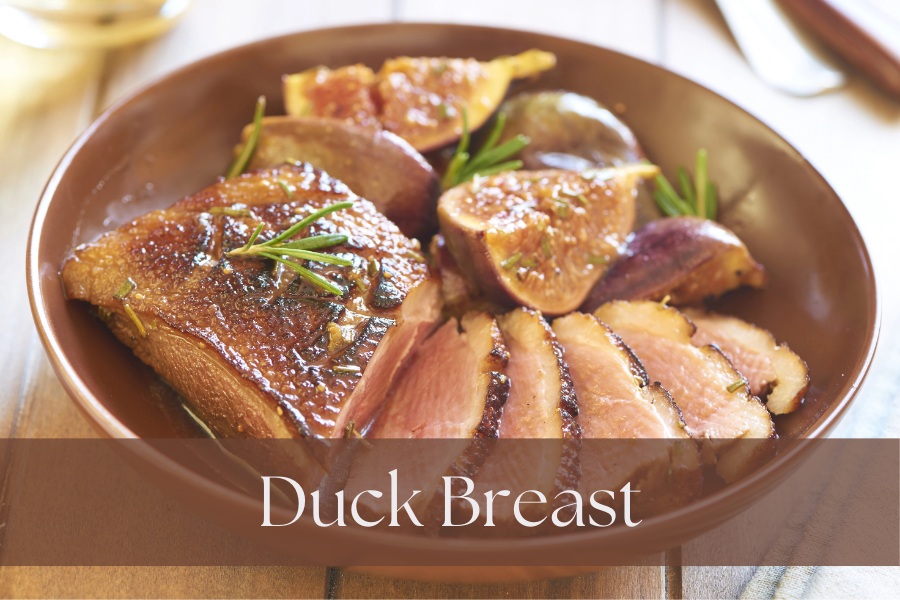Duck Breast

Cooked duck breast is a rich and flavourful dish. It is known for its tender meat and crispy, golden-brown skin. When the duck is cooked properly, the fat renders out leaving you with a beautiful crispy exterior while the meat inside is juicy. Duck breast has a slightly gamey taste to it compared to chicken, but once you try it, you will love the taste!
In this blog post, you will learn how to make duck breast.
How to Make Duck Breast Fillets
Remove the packaging from your duck breast fillets. Score the fat side of the duck breast in a crisscross direction. Place the duck breasts fat side down on a cold frying pan and turn it on to medium heat. As the pan begins to heat up, the fat will begin to render from the duck breast. Fry until the duck fat turns into a golden-brown colour, time is dependent on the speed and heat of your own hob. Flip the fillets over and fry for another 2-3 minutes. Once the fillets are finished frying, place the duck breast fillets onto a lined baking parchment sheet. Cook for 10-15 minutes in the oven. Remove from the oven and let rest for 5 minutes before slicing them up.
How Long Can I Store Duck Fat For?
Even if you do not plan on eating the duck fat, make sure to leave it on for cooking as the fat allows you to cook the fillet gently and evenly giving you a tender duck breast. And when you are finished cooking, you can save the duck fat! You can store your duck fat for an extended period of time if handled properly.
You can store duck fat in the refrigerator for up to 6 months when stored in an airtight container. Be sure to strain any bits of food from it before storing to ensure it stays fresh.
You can store duck fat in the freezer for up to a year when frozen. Use an airtight container or freezer-safe bag for long-term storage. When ready to use, simply thaw the duck fat in the refrigerator or at room temperature.
What Temperature Should my Duck Reach?
Duck breast should reach an internal temperature of 165°F (75°C) to be eaten safely, according to food safety guidelines. However, it is often served medium-rare, at around 135°F to 140°F (57°C to 60°C) for optimal tenderness and flavour. Duck is similar to red meat in that it can be served medium-rare unlike chicken. It also has a colour and texture similar to that of red meat If you are cooking whole duck or duck legs, aim for the higher temperature (165°F) for safe and fully cooked meat. Always use a meat thermometer to ensure accuracy.
Best Side Dishes for Duck Breast
Duck pairs beautifully with a range of side dishes that complement its rich, slightly gamey flavour. Here are some great side dishes to serve with duck.
- Roasted Vegetables such as roasted carrots, parsnips, or beets.
- Potato Gratin or Mashed Potatoes
- Sauteed Greens such as leafy greens like spinach, Swiss chard, or kale, sautéed with garlic or lemon.
- Wild Rice or Quinoa
- Cranberry or Orange Sauce
- Roasted or Grilled Asparagus
- Polenta
- Brussels Sprouts
These side dishes are great at balancing out the duck’s natural richness, offering a mix of flavours and textures that elevate the meal.
Do Figs Pair Well with Duck Breast?
Figs pair beautifully with duck breast. Their natural sweetness and slight chewiness complement the rich, savoury flavor of this meal. Figs, whether fresh or dried, bring a touch of fruitiness that balances out the fatty and flavorful nature. You can serve them roasted or caramelized alongside the duck or incorporate them into a sauce, such as a fig and balsamic reduction. The combination of sweet figs with the savoury, crispy duck skin creates a delicious contrast that is popular in many gourmet dishes.
Ingredients
Duck Breast: the star of this dish is the duck breast with its rich but slightly gamey flavour. When cooked properly, you are left with a gorgeous, golden-brown skin that tastes amazing!
Salt: salt is used to enhance the duck and to season it.
Black Pepper: black pepper adds a mild heat and an earthy flavour to the meat.
Tips
- Make sure to keep the duck fat to use on your Oven Roasted Potatoes.
- Fresh or dried figs can be eaten with the this meal which can help to balance out the fatty nature of the duck.
- When scoring the duck fat, do not score so deeply that you reach the meat portion of the fillet as this can lead to the duck breast drying out during cooking.

Duck Breast
Ingredients
- 2 duck fillets
- Salt to taste
- Black pepper to taste
Instructions
- Preheat oven to 400℉/200℃/Gas Mark 6.
- Remove the duck breast from the package and score the side with the fat on it in a crisscross pattern. Season with salt and pepper.
- Place the duck breast fillets fat side down on a cold frying pan. Turn on the pan and bring it to a medium heat. As the pan starts to heat, the fat will begin to pull away from the fillets. Cook until the fat turns a golden colour. (Time will depend on the speed of your hob.)
- Once the fat has turned golden, flip the duck breast fillet and fry for another 2-3 minutes.
- Remove from the heat and place the fillets onto a lined baking sheet, place into the oven, and cook the fillets for 10-15 minutes.
- Remove from the oven and let the duck breast fillets rest for 5 minutes before slicing. Make sure that the no pink meat remains, and the juices run clear.
Notes
Author: Sarah Young
In this blog post, you learned how to make duck breast fillets.